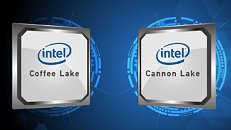Raevenlord
News Editor
- Joined
- Aug 12, 2016
- Messages
- 3,755 (1.23/day)
- Location
- Portugal
| System Name | The Ryzening |
|---|---|
| Processor | AMD Ryzen 9 5900X |
| Motherboard | MSI X570 MAG TOMAHAWK |
| Cooling | Lian Li Galahad 360mm AIO |
| Memory | 32 GB G.Skill Trident Z F4-3733 (4x 8 GB) |
| Video Card(s) | Gigabyte RTX 3070 Ti |
| Storage | Boot: Transcend MTE220S 2TB, Kintson A2000 1TB, Seagate Firewolf Pro 14 TB |
| Display(s) | Acer Nitro VG270UP (1440p 144 Hz IPS) |
| Case | Lian Li O11DX Dynamic White |
| Audio Device(s) | iFi Audio Zen DAC |
| Power Supply | Seasonic Focus+ 750 W |
| Mouse | Cooler Master Masterkeys Lite L |
| Keyboard | Cooler Master Masterkeys Lite L |
| Software | Windows 10 x64 |
According to DigiTimes, sources among Taiwan-based PC vendors have indicated that Intel's upcoming Basin Falls platform, which includes Skylake-X and Kaby Lake-X processors on a new X299 chipset, will be unveiled at Computex 2017 (May 30th, June 3rd), in Taipei - two months earlier than expected. This move comes accompanied by an accelerated launch of the Coffee Lake microarchitecture, which still uses the 14 nm process, to August 2017 from an initial January 2018 launch. If true, this is big in a number of ways - that Intel would bring forward a product launch 4 months has some interesting implications - or at least, confirmations.
Remember that Coffee Lake is supposed to carry an increased number of cores in its mainstream designs. And we all know how Intel's line-up has almost been torn apart by Ryzen's aggressive core and thread-count, with AMD offering more cores and threads than Intel at virtually all price-points. And even if an argument is made regarding Intel's better gaming performance, that's one scenario out of many. Future proofing, professional work, multimedia, all of these assert AMD's dominance in a pure price-performance ratio. I, for one, would gladly give up some FPS in some games and accept an increased number of cores than go the other way around (especially with AMD's platform support and the number of patches that have increased game performance on Ryzen CPUs.)



So what we see here, if these reports are correct, is Intel scrambling to respond to a launch that caught the blue giant squarely with its figurative pants down - Ryzen's 52% performance increase (and incredible energy efficiency) over the now defunct and best-forgotten Bulldozer debacle was something Intel wasn't quite counting on. Intel had three choices: keep its stalwart posture with no price decreases on its line-up and see Ryzen CPUs flying off the shelves, as they mostly have; do an about-face and lower pricing, which would indelibly mark its standing and image as an untouchable tech giant; or accelerate the launch of its upcoming platform, with a line-up that is actually better equipped to handle Ryzen's core and thread dominance. If the last one is true, then this is no small feat for Intel itself, and just goes to show how the company could have increased core-count on its processors any time it wanted. Instead, they took the sound business decision in face of lacking competition - but those are all decisions that now show us how ridiculous it is that Intel is selling two-core, four thread i3 processors for the premium it has.
Back to the news piece, these Basin Falls-based products are expected to be revealed near the E3 gaming show in June, with the official release at the end of the month. It is currently expected that the Skylake-X series features three 140W processors with 6, 8 and 10-core designs, while the Kaby Lake-X series carries a 112 W, quad-core processor. In August, Intel will release a top-end 12-core Skylake-X processor. These will probably enter a collision course with AMD's expected X399 platform, which again boast of higher core-counts - and probably better performance-per-watt - than Intel's offerings, with 12 and 16-core processors (with double the threads) being available.
As for the 14nm-based Coffee Lake-based processors, which are supposed to bring Intel back in the mainstream processor game, the company is expected to initially release several K-series Core i7/i5/i3 processors and accompanying Z370 chipsets in August, with more CPUs and the H370, B360 and H310 chipsets at the end of 2017 or early 2018. Digitimes also reports that Intel has ordered five extra EUV machine sets from ASML in an effort to increase its manufacturing capabilities. If all of this pans out the way it's looking, I think "scrambling" is a more than fair description on the current Intel landscape.
View at TechPowerUp Main Site
Remember that Coffee Lake is supposed to carry an increased number of cores in its mainstream designs. And we all know how Intel's line-up has almost been torn apart by Ryzen's aggressive core and thread-count, with AMD offering more cores and threads than Intel at virtually all price-points. And even if an argument is made regarding Intel's better gaming performance, that's one scenario out of many. Future proofing, professional work, multimedia, all of these assert AMD's dominance in a pure price-performance ratio. I, for one, would gladly give up some FPS in some games and accept an increased number of cores than go the other way around (especially with AMD's platform support and the number of patches that have increased game performance on Ryzen CPUs.)



So what we see here, if these reports are correct, is Intel scrambling to respond to a launch that caught the blue giant squarely with its figurative pants down - Ryzen's 52% performance increase (and incredible energy efficiency) over the now defunct and best-forgotten Bulldozer debacle was something Intel wasn't quite counting on. Intel had three choices: keep its stalwart posture with no price decreases on its line-up and see Ryzen CPUs flying off the shelves, as they mostly have; do an about-face and lower pricing, which would indelibly mark its standing and image as an untouchable tech giant; or accelerate the launch of its upcoming platform, with a line-up that is actually better equipped to handle Ryzen's core and thread dominance. If the last one is true, then this is no small feat for Intel itself, and just goes to show how the company could have increased core-count on its processors any time it wanted. Instead, they took the sound business decision in face of lacking competition - but those are all decisions that now show us how ridiculous it is that Intel is selling two-core, four thread i3 processors for the premium it has.
Back to the news piece, these Basin Falls-based products are expected to be revealed near the E3 gaming show in June, with the official release at the end of the month. It is currently expected that the Skylake-X series features three 140W processors with 6, 8 and 10-core designs, while the Kaby Lake-X series carries a 112 W, quad-core processor. In August, Intel will release a top-end 12-core Skylake-X processor. These will probably enter a collision course with AMD's expected X399 platform, which again boast of higher core-counts - and probably better performance-per-watt - than Intel's offerings, with 12 and 16-core processors (with double the threads) being available.
As for the 14nm-based Coffee Lake-based processors, which are supposed to bring Intel back in the mainstream processor game, the company is expected to initially release several K-series Core i7/i5/i3 processors and accompanying Z370 chipsets in August, with more CPUs and the H370, B360 and H310 chipsets at the end of 2017 or early 2018. Digitimes also reports that Intel has ordered five extra EUV machine sets from ASML in an effort to increase its manufacturing capabilities. If all of this pans out the way it's looking, I think "scrambling" is a more than fair description on the current Intel landscape.
View at TechPowerUp Main Site







